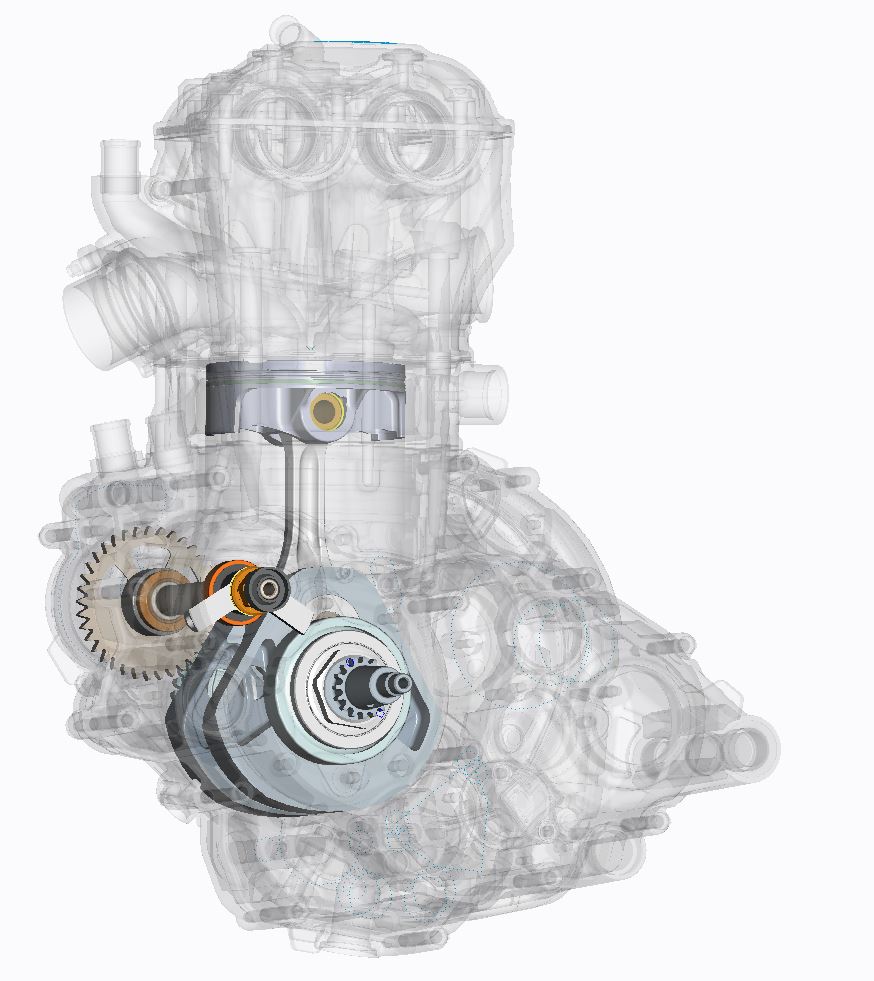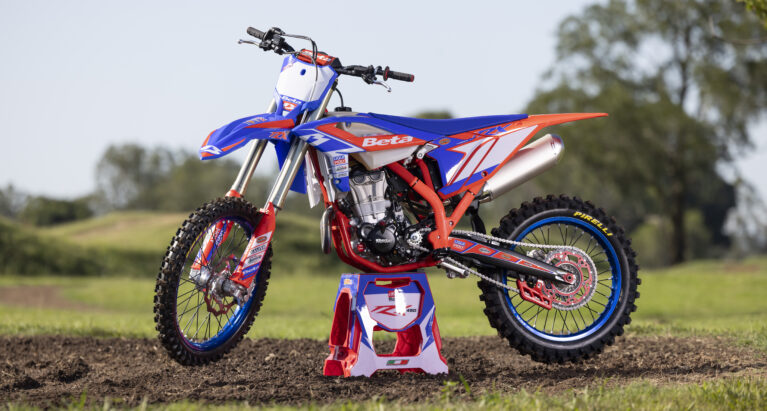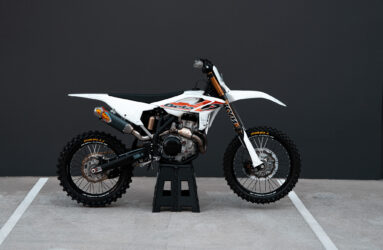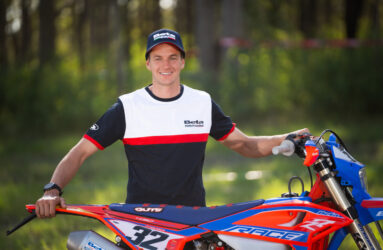BETA’S RX450: MX THOROUGHBRED!
Is Beta’s first ever 450cc motocross bike based heavily on its enduro-spec cousins? Or has it been designed as a purebred MX race weapon? We speak with Beta Australia technician, Vic Martin, for an insight into the all-new RX450’s design approach and component spec.
So, what do we know about Beta’s all-new RX450 motocross machine? Is it an enduro model fitted with a 19-inch rear and firmer suspension settings? Or has it been purpose-built from the ground up as a dedicated motocross race weapon? After speaking with long-time motorcycle tech guru, Beta Australia’s Vic Martin, we discovered that the RX450 shares surprisingly few parts with its enduro-going cousins…
TM: What do you say to the sceptics who claim Beta’s RX450 is simply an enduro-ized version of its similar-capacity RR Racing enduro-model cousins, the 430 or 480?
VM: I’d say they need to look a little closer at the two machines side by side and at each model’s spec sheet [laughs]. That will soon reveal not too many components are shared across Beta’s enduro and motocross models.

Why is Beta’s RX300 two-stroke MXer perceived to be very similar to the RR300 Racing enduro model is based off, rather than as a dedicated MX model?
I suppose that’s because the 300cc two-stroke enduro models have been so successful for Beta for several years – in terms of enduro racing success and dealer sales. For instance, people tend to just look at the fact that both the RX300 and RR300 Racing run Kayaba suspension, but they’re not aware that the MX models’ fork and shock each have different internals, 10mm more travel, and very different settings. That’s just one example of many differences between the enduro and MX models that people tend to overlook. Which is understandable, I guess, as Beta is relatively new to the MX market.

Okay, so back to the RX450. Take us through the key differences in their DOHC engines – aside from the fact that the RX450’s 97mm piston diameter sits between the RR430’s 95mm and RR480’s 100mm slug, albeit with the same 60.8mm stroke.
The RX450’s cylinder head is different to accommodate the unique bore size. There are also differences in the engines’ crankshaft, transmission, throttle body (46mm diameter versus the enduro bike’s 42mm), ECU, cam profiles, airbox and intake boot, inner and outer clutch cover, and the stator and wiring loom. The RX450 runs a lighter balancer shaft to make it a little faster revving. The 450’s muffler is a smaller, MX-style unit. Its MX-spec exhaust header is made for Beta by HGS, and the way the whole exhaust system mounts to the frame is also very different. In fact, the RX450’s standard exhaust system is so good, I know that a few of the aftermarket exhaust brands struggled to improve on the thing. You’ll also notice the RX450’s engine cases use a different mould. The kick-start boss – which is on the enduro models’ cases (to give you the option of retro-fitting a kick-start) – is not there on the RX450. In other words, there’s a hell of a lot of differences! Beta doesn’t like to make horsepower claims, but one of our Aussie dealers recently put the RX450 on the dyno and got a very healthy 57.6hp out of it – about 13hp more than the similar-capacity enduro engine. On the scales, the MX and enduro models differ by about 4kg. Dry weight (fluids, but no fuel) for the RX450 is claimed to be 104.5kg, whereas the RR430/480 Racing is 108.5kg.



Take us through the differences in the clutch and transmission components in a bit more detail, Vic.
Sure. The clutch plates – both fibres and steels – are the same between the RX450 and enduro models. As is the clutch’s inner boss and basket. But there are differences in the outer pressure plate, and the RX450’s diaphragm spring is stiffer, but still has the three-settings option. Obviously, the MX model uses a five-speed transmission with dedicated ratios, while the enduro bikes are six-speed.
What parts do the MX and enduro engines share?
They share the valve springs and the DLC-coated finger followers, along with the electric starter.

What about the ergos and bodywork? Obviously, the 9L enduro fuel tank is reduced to 7L for the MX bike, and a front plate replaces the headlight, but what about the rest of the plastics?
The only shared bodywork parts are the tank-shroud plastics, front mud guard and the fork protectors. Because the RX450 runs an alloy subframe (rather than the plastic composite subframes on the enduro bikes) and a completely different airbox, everything from the middle of the bike back is very different. The RX450 uses a three-piece set-up with the sideplates and rear guard, whereas the enduro bikes use a one-piece design there. The blue gripper seat cover only comes on the RX450, though you can fit an enduro seat to it if you want to. When you look at the MX and enduro models’ cockpits side by side, the RX’s tank and seat appear visibly lower relative to the headstock, which makes its cockpit more spacious and helps creates extra room for your legs when you’re cranked over through ruts.
Okay, so let’s talk about the two models’ rolling chassis – differences and similarities…
The swingarm is RX450-specific, however the rising-rate shock linkage is shared across MX and enduro models. Same goes with the triple clamps, which both run the same 25mm offset. And their chassis geometry is very similar. But that’s about the only parts common to both. The main spar of the RX450’s chromoly frame is visibly beefed up for added rigidity to withstand repeated jump landings, and there are a few other less obvious tweaks to the frame and its flex characteristics (in addition to the totally different alloy subframe we discussed earlier).
And even though the fork and shock are the same KYB units, the differences between the MX and enduro models’ suspension are more significant than people realise, right?
Yep, the MX models’ have 10mm more travel at each end. That means a different cartridge and other internal components in the Kayaba closed-cartridge fork. The RX450’s dedicated MX shock also gives you 10mm more travel, and the main shock body uses a 50mm piston compared with the enduro bikes’ 46mm.




The brakes differ slightly too, right?
That’s right. Both MX and enduro models run the 260mm/240mm front/rear brake discs, but the RX450 uses a new, lighter, smaller Nissin front calliper that the Yamaha YZ-Fs run for more bite and feel, whereas Beta’s enduro bikes run the previous-model Nissin calliper with the larger pistons. The RX450 uses the same rear brake calliper, but an all-new rear brake master cylinder reservoir that’s mounted horizontally (now also fitted to the 2024 RR Racing models) to allow more space around the exhaust.
And finally, what about running gear componentry? What’s shared there?
The hubs and front spokes are shared across MX and enduro models – though the RX’s rims are blue instead of black, and has the 19-inch rear. Also shared across RX and RR models are sprockets, chain guide, hubs, rear disc, rear brake calliper, footpegs and handlebars (made by Reikon). In other words, the two models only share components where it makes sense, rather than compromising performance to save on shared component costs.
BETA … A MOTOCROSS BRAND?
What does Beta mean to most people? A 119-year-old Italian motorcycle manufacturer that specialises in high-end enduro and trial bikes, right? Right! Well … right until a few years ago, when Beta signalled its intentions to enter the modern-day MX market by revealing a prototype 300cc two-stroke motocross machine: the 2021 RX300. Based on Beta’s RR300 Racing (the up-specced enduro model that’s fitted with a Kayaba fork and shock), the RX300 was produced solely for the MX-obsessed American market in 2021 (and only in limited numbers). Pitched to appeal to “the two-stroke motocross enthusiast”, the RX300 retained the electric-start, but got a 19-inch rear wheel, along with MX-spec engine, frame, ergos and suspension settings, plus a few other component upgrades.

And that American-market gamble paid off for the Italians. Beta’s first MX bike (since the 1980s, anyway) was so popular, they went ahead and showered the 2022 and 2023 RX300 with a series of engine, suspension and componentry upgrades, and made the model available to export markets outside the USA – Europe and Australia included (click here to check out our feedback after testing the 2023 RX300).
Meantime, since 2021 – and to underline their intentions in the MX bike market – Beta has also been campaigning a prototype RX450 four-stroke machine in the MXGP World Championship, where they’ve posted some very respectable top-10 results. And then to really put the machine in the spotlight, Beta officially entered the AMA Supercross Championship this year, where team riders Colt Nichols and Benny Bloss did enough to demonstrate the RX450 was competitive in what’s arguably the most cut-throat off-race race series in the world. All of which culminated in Beta’s announcement late last year that they’d be releasing their first production-model RX450 in early 2024.

So, what started as a dabble into the MX market has certainly gathered some momentum. And it’ll be very interesting to see how Beta’s RX450 sells over the coming year or two. Beta has already forged a dedicated following in recent years with their huge range of world-class enduro models – backed up by a slew of EnduroGP World Championship titles – which is why Aussie Beta dealerships are very excited about the brand’s venture into the MX market and the opportunities it presents them with.









Be the first to comment...